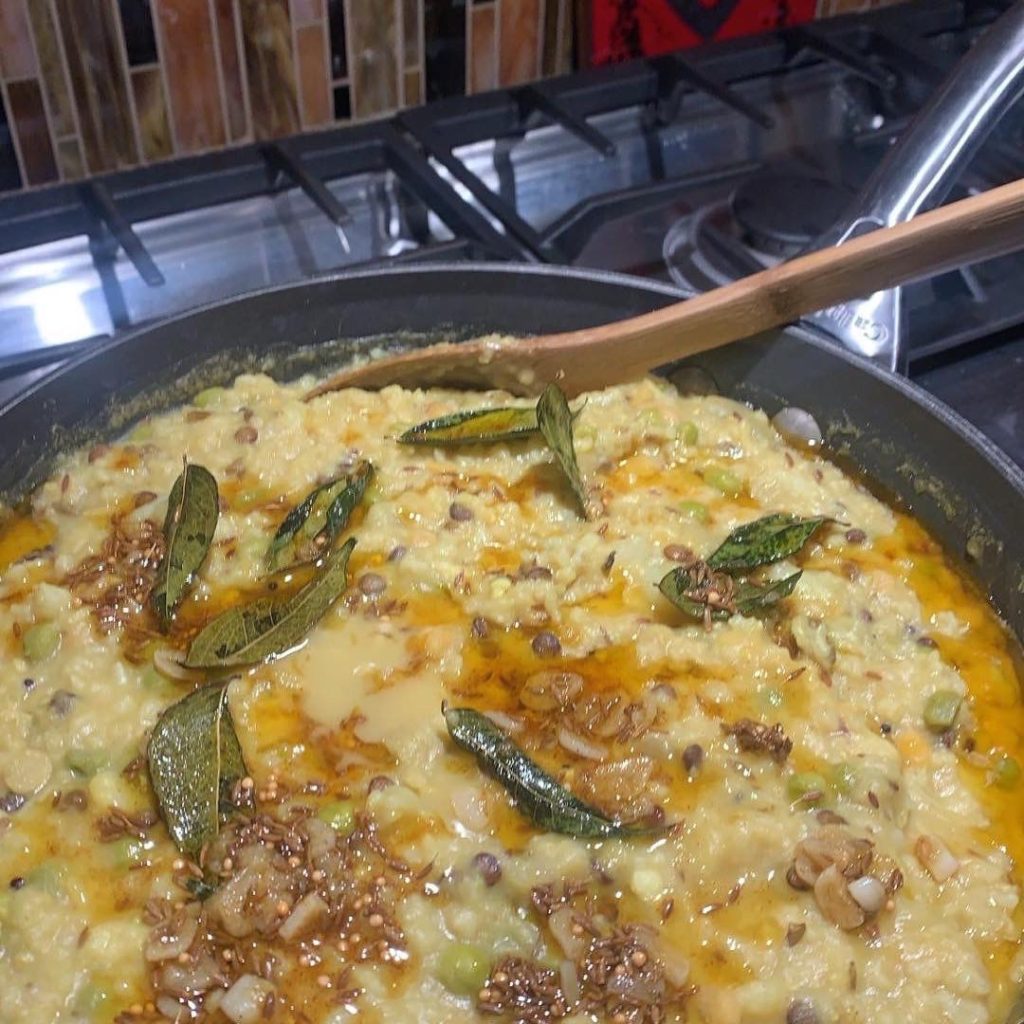
One of the most nostalgic moments from my childhood is eating my mom’s kichari. This dish was more that just a meal. It represented pure comfort. I genuinely never got sick of it. In fact, whenever I felt even slightly under the weather my mom would whip out this dish, and often serve it with the savory soup kardi.
Kitchari is considered a classic Ayurvedic dish. Widely touted for its detoxifying nature. Often this dish is eaten during periods of intermittent fasting, or when cleansing.
This powerhouse of a dish is a staple in the homes of Indians from a range of social-economic background. Its packed with a balance of protein, fiber, and nutrients. When my husband, Rich, first met me, I shared some left of kichari and referred to it jokingly as “the poor man’s food”. Upon tasting it, Rich immediately expressed that to him this dish is fit for kings. My point is that the ingredients of this dish is fairly accessible to most people in India.
Essentially, this dish is made with a mixture of lentils, rice, and vegetables infused with spiced ghee (vagar). There are various ways in which this dish can be prepared. In fact, my mom’s version (which I thought was the best variation) was vastly different than that of my relatives or other friends. My mom used to make her version in a pressure cooking, however I use my Instapot to prepare this dish.
I prefer this dish to be slightly smoother in texture, more porridge like. Once you get the hang of this dish, you can continually customize it until it feels just right for you.
Ingredients
- 2 tbs ghee (or oil of your choice)
- 2-3 tsp salt
- 1 tbs cumin seeds
- 1 tsp black mustard seeds
- 1 pinch asafoetida (hing)
- 1 clove (or a pinch of clove powder)
- 2-3 whole peppercorns
- 5-7 curry leaves (mitho limdo)
- I full heartedly believe that the addition to the fresh curry leaves which I have accessible through friends and relatives who grown them, makes a huge difference in resulting flavors. Don’t even get me started on the distinctions between Bay Leaves vs. Curry Leaves.
- 1 cup brown basmati rice
- You can different kinds of rice, but I just prefer brown rice.
- 1 cup mixed lentils.
- I use a combination of what I have available. If you aren’t too familiar with lentils, I suggest you check out this quick guide.
- split and skinner green gram (mung)
- split red lentils (masoor)
- yellow pigeon peas (toor)
- split bengal gram (chana)
- skinned black gram (urad)
- I use a combination of what I have available. If you aren’t too familiar with lentils, I suggest you check out this quick guide.
- 3 cups of vegetables.
- Again, I use a combination of what I have available. I prefer the below listed veggies in my kitchari.
- 2-3 cloves garlic (minced)
- 1 yellow onion (thinly sliced)
- 2-3 red potatoes (cubed)
- 1 medium sized Cauliflower (chopped)
- 1 cup Peas
- Again, I use a combination of what I have available. I prefer the below listed veggies in my kitchari.
- 6 cups of water
The Process
- Rinse and soak your rice for 15-30 minutes.
- In a separate bowl rinse your lentils, and also soak for 15-30 minutes.
- While your rice is soaking wash and cut your vegetables.
- In a plate have all of your spices laid out, and separately set have the minced garlic and sliced onions ready for the saute.
- Turn on your Instapot, and set to Saute Mode (1 cycle is 30 seconds) to prepare your vagar
- Vagar: An East Indian term, is also referred to as tempering or blooming. This is a cooking technique used in the eastern cuisines, involving gently frying whole spices (such as, cumin) and other ingredients (such as, dried chillies, or minced garlic) to roast the spices resulting in reducing the bitterness of some of the whole spices, while deepening or enhancing their flavors.
- Add the ghee, and once heated stir in a pinch of the asafoetida, the cumin seeds, the 2-3 curry leaves, the clove, and the pepper corns.
- Keep stirring until the spices are slightly toasted, and then add in the garlic and onions. Continue stirring until the onions are translucent or slightly browned.
- Stir in the rice and lentil.
- Add the 6 cups of water.
- Stir in the turmeric and salt.
- Close the Instapot lid
- Close the pressure valve to Sealing.
- Cook at high pressure for 20 minutes, allowing natural pressure to release during that time.
- After 20 minutes open the pressure valve to release any remaining pressure.
- Transfer the contents into a large bowl.
- Optional: In a small sauce pan prepare a vagar using the remaining curry leaves and cumin. Pour over the kitchari. The crispiness of the curry leaves, the toasted cumin, and the dash of minced garlic tastes enhances the kitchari with a burst of flavors.